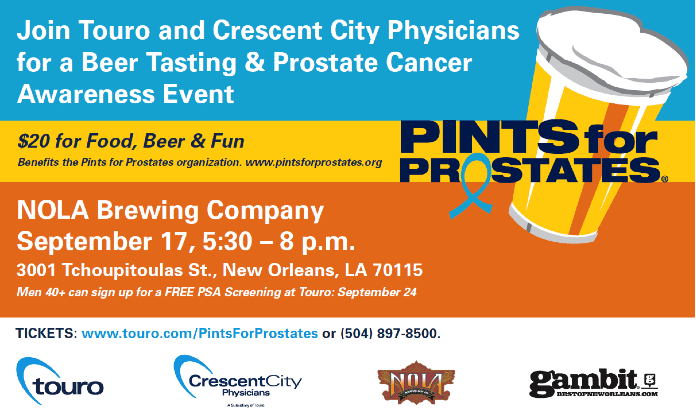Disclosure :: this post is sponsored by Touro Infirmary.
What is a prostate?
The prostate gland is only found in men and is about the size of a walnut. Its primary function is to create fluid that nourishes and protects sperm. The gland pushes this fluid through the urethra, or the tube from the bladder, and the fluid is expelled with sperm during ejaculation, creating semen. The prostate gland is located below the bladder, in front of the rectum, and surrounds part of the urethra.
Keeping your prostate healthy
Prostate problems are a natural part of aging. However, there are lifestyle changes you can make to keep your prostate healthy. A diet low in saturated fats and rich in fruits and vegetables may lower risks of developing an enlarged prostate. Finally, good hygiene is recommended to help prevent prostatitis and to keep the prostate healthy.
Prostate Cancer
 Prostate cancer is a malignant tumor of the prostate gland. It is the second highest occurring cancer in men. One in six men will be diagnosed with prostate cancer, but only one in 35 men will die from the disease, due to its slow progression. It is not known what exactly causes prostate cancer, but the risk increases with age. Two thirds of men diagnosed with the condition are over the age of 65.
Prostate cancer is a malignant tumor of the prostate gland. It is the second highest occurring cancer in men. One in six men will be diagnosed with prostate cancer, but only one in 35 men will die from the disease, due to its slow progression. It is not known what exactly causes prostate cancer, but the risk increases with age. Two thirds of men diagnosed with the condition are over the age of 65.
There are two major risk factors: family history and race. If your father or brother was diagnosed with prostate cancer, your risk for the condition doubles. African-American men are diagnosed more often than Caucasians, and upon diagnosis, the disease is usually more advanced. Most of the time, prostate cancer has no symptoms.
“Men who end up diagnosed with prostate cancer are typically asymptomatic until the later stages,” warns Touro’s Dr. Richard Vanlangendonck, a board-certified urologist, fellowship-trained in minimally invasive urologic surgery, whose primary focus is on prostate and kidney cancers.
Prostate-Specific Antigen (PSA) test
The PSA test is performed to examine the levels of the prostate-specific antigen in the blood stream. Healthy men have low levels; levels increase as the prostate grows in size, even for benign growth, though at a slower rate. Other activities may also cause the PSA level to rise, such as sexual activity, injury, or prostatitis. Though routine testing is controversial, the decision to screen for prostate cancer with the PSA test at age 50 and older is a decision that should be made by the well-informed patient with the assistance of his primary care physician or urologist. Men with higher risk factors may receive the test at the age 40 or 45.
To schedule an appointment with Dr. Vanlangendonck to learn more about your prostate health, please call 504.897.7196.
Office Location: 3434 Prytania Street (Buckman Building), Suite 450, New Orleans, LA 70115

Join us in our annual Pints for Prostates event
Click HERE to purchase tickets.
About Richard Vanlangendonck, M.D.
 Richard Vanlangendonck, M.D. is a board-certified urologist, fellowship-trained in minimally invasive urologic surgery, whose primary focus is on prostate and kidney cancers.
Richard Vanlangendonck, M.D. is a board-certified urologist, fellowship-trained in minimally invasive urologic surgery, whose primary focus is on prostate and kidney cancers.
















